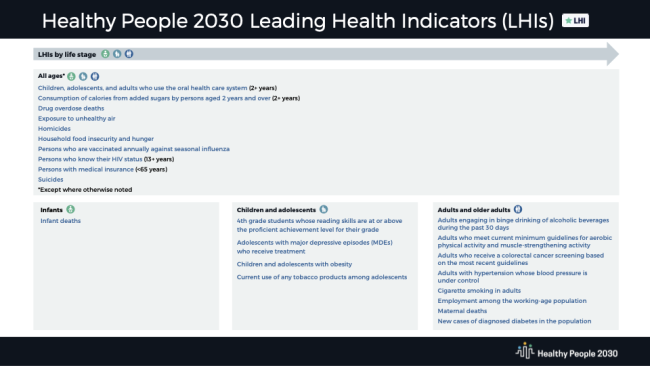Healthy People 2030 LHI infographics are innovative visual interpretations of the overall data and select population disparities data.
Leading Health Indicators


Leading Health Indicators (LHIs) are a small subset of high-priority Healthy People 2030 objectives selected to drive action toward improving health and well-being. As a set, LHIs cover the life span and include objectives across topic areas. Most LHIs address important factors that impact major causes of death and disease in the United States, and they help organizations, communities, and states across the nation focus their resources and efforts to improve the health and well-being of all people. Healthy People 2030 includes 23 LHIs.
And to learn how LHIs are connected to other Healthy People objectives and the Healthy People 2030 vision, check out our Healthy People 2030 Objectives and Measures graphic.

Interested in tracking LHIs over the decade? Use the Healthy People 2030 Leading Health Indicators Custom List.
Look for the LHI label on individual objective pages — it indicates that an objective is also an LHI.
LHIs by life stage
All ages*
Children, adolescents, and adults who use the oral health care system (2+ years)
Consumption of calories from added sugars by persons aged 2 years and over (2+ years)
Household food insecurity and hunger
Persons who are vaccinated annually against seasonal influenza
Persons who know their HIV status (13+ years)
Persons with medical insurance (<65 years)
* Except where otherwise noted
Infants
Children and adolescents
Adolescents with major depressive episodes (MDEs) who receive treatment

LHIs by life stages graphic
Selection Criteria for Leading Health Indicators
LHIs were selected based on:
- Recommendations from the Secretary’s Advisory Committee on National Health Promotion and Disease Prevention Objectives for 2030 [PDF - 164 KB]
- Recommendations from the National Academies of Sciences, Engineering, and Medicine LHI Committee
- Input from subject matter experts and the Federal Interagency Workgroup
As a set, LHIs cover the life span. Based on the selection criteria, all LHIs:
- Are core objectives
- Focus on upstream measures, such as risk factors and behaviors, rather than disease outcomes
- Address issues of national importance
- Address high-priority public health issues that have a major impact on public health outcomes
- Are modifiable in the short term (through evidence-based interventions and strategies to motivate action at the national, state, local, and community level)
- Address social determinants of health and health disparities
- Have new data available periodically, preferably annually
Data Requirements for Leading Health Indicators
Data requirements for LHIs include:
- Valid, reliable, nationally representative data
- Data with no major methodological concerns
- Data with demographic and geographic detail (preferred)
- Federal government management or oversight of data sources
- Publicly available data sources